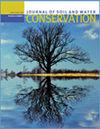Managed aquifer recharge using a borrow pit in connection with the Mississippi River Valley alluvial aquifer in northeastern Arkansas
IF 2.6
4区 农林科学
Q2 ECOLOGY
引用次数: 0
Abstract
The Mississippi River Valley alluvial aquifer (MRVAA) is one of the overexploited aquifers in the United States. Agriculture in Arkansas relies significantly on the MRVAA for irrigation, due to its accessibility and high yield. Increased irrigation demand since the early 1900s with continued expansion and inequitable recharge contributions resulted in groundwater decline. Overdraft of the MRVAA in Arkansas has resulted in the designation of critical groundwater areas. Managed aquifer recharge (MAR) methods intentionally replenish stressed groundwater resources. A MAR case study was conducted to determine whether infiltration basins, as repurposed borrow pits, could be used to enhance groundwater decline in critical groundwater areas of northeast Arkansas. This rehabilitation would be a practical solution to alleviate groundwater decline as well as economically feasible as land would not need to be taken out of production. In 2015, the Arkansas Department of Transportation contracted sand excavation of fallow land owned by a collaborating producer. This borrow pit would serve as a test case to measure infiltration rates into the MRVAA using nearby surface water as the recharge source. Initial soil core analyses revealed soil properties within the confining clay layer of red-brown clay and silty clay soils (0 to 3.7 m deep) with sand below. Excavation completed to a depth of ~6 m exposed the uppermost-unsaturated section of the alluvial aquifer, consisting of well-sorted medium grain size sand. The borrow pit floor was ~27 m above the existing water table, and it was hypothesized that this exposed unsaturated aquifer section would provide a natural filter and an avenue for increased water storage underground. Sediment samples were collected from the pit floor and sidewall pre- and postexperiment to characterize particle size, textural class, and organic matter. Submersible pressure transducers were installed within the pit and in a nearby irrigation well to monitor water level changes. Meteorological data were collected on-site to measure the water budget components of precipitation and evaporation. Water level declines and infiltration were evident throughout the experiment. An initial infiltration rate of 192 mm d−1 was measured in February of 2016 that decreased until March, with steady state rates of 4.43 to 136 mm d−1 that varied until June. An overall integrated infiltration rate of 36.4 mm d−1 was calculated from the water budget. Total subsurface storage increased by 9.3 ML from February to June of 2016, and a two-dimensional simulation predicted a maximum groundwater mounding of 2.6 m during the experiment. Additionally, 14 borrow pits that had not been repurposed were identified in the area using remote sensing. Results of this study demonstrate that a relatively inexpensive MAR strategy could be implemented using former borrow pits repurposed as infiltration basins to alleviate groundwater decline in a critical groundwater area of northeastern Arkansas.利用与阿肯色州东北部密西西比河流域冲积含水层有关的借用坑管理含水层补给
密西西比河流域冲积含水层(MRVAA)是美国过度开发的含水层之一。阿肯色州的农业很大程度上依赖于MRVAA灌溉,因为它的可及性和高产量。自20世纪初以来,灌溉需求不断增加,随着不断的扩张和不公平的补给贡献,导致地下水减少。阿肯色州MRVAA的透支导致了关键地下水区域的指定。管理含水层补给(MAR)方法有意补充承压地下水资源。通过MAR案例研究,确定渗透盆地作为改作用途的借用坑是否可以用来加强阿肯色州东北部关键地下水区域的地下水下降。这种恢复将是缓解地下水下降的实际解决办法,而且在经济上是可行的,因为土地不需要停止生产。2015年,阿肯色州运输部承包了一家合作生产商拥有的休耕土地的挖沙工作。这个借用坑将作为一个测试案例,以测量使用附近地表水作为补给源进入MRVAA的渗透速率。最初的土壤核心分析揭示了红褐色粘土和粉质粘土(0至3.7 m深)的粘土层内的土壤特性,下面是沙子。挖掘深度约6 m,暴露了冲积含水层的最上层非饱和部分,由分选良好的中等粒度砂组成。借坑底板高于现有地下水位约27 m,假设这一暴露的非饱和含水层段将为增加地下储水量提供天然过滤器和通道。实验前和实验后从坑底和侧壁收集沉积物样本,以表征颗粒大小、质地类别和有机质。在坑内和附近的灌溉井中安装了潜水式压力传感器,以监测水位变化。现场采集气象资料,测量降水和蒸发水分收支分量。在整个试验过程中,水位下降和入渗都很明显。2016年2月测得的初始入渗速率为192 mm d - 1,一直下降到3月,稳定状态速率为4.43 ~ 136 mm d - 1,一直变化到6月。根据水收支计算得到的总综合入渗速率为36.4 mm d−1。2016年2 - 6月地下总库存量增加9.3 ML,二维模拟预测试验期间地下水最大隆起2.6 m。此外,利用遥感在该地区查明了14个未改作用途的借用坑。本研究的结果表明,在阿肯色州东北部的一个关键地下水区,利用以前的借用坑作为渗透盆地,可以实施一种相对廉价的MAR策略,以缓解地下水的下降。
本文章由计算机程序翻译,如有差异,请以英文原文为准。
求助全文
约1分钟内获得全文
求助全文
来源期刊
CiteScore
4.10
自引率
2.60%
发文量
0
审稿时长
3.3 months
期刊介绍:
The Journal of Soil and Water Conservation (JSWC) is a multidisciplinary journal of natural resource conservation research, practice, policy, and perspectives. The journal has two sections: the A Section containing various departments and features, and the Research Section containing peer-reviewed research papers.

 求助内容:
求助内容: 应助结果提醒方式:
应助结果提醒方式:


